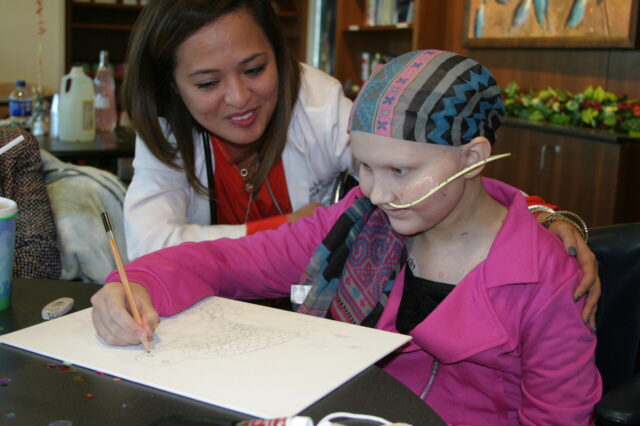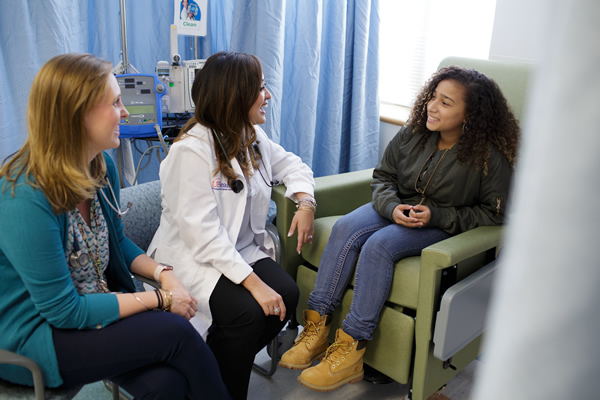Get the Facts on Childhood Rhabdomyosarcoma

July brings awareness to the cancer that is responsible for 10 percent of all childhood cancer-related deaths: sarcoma. In recognition of Sarcoma Awareness Month, it’s crucial to discuss the soft tissue sarcoma making up three percent of all childhood cancers, rhabdomyosarcoma.
What is Rhabdomyosarcoma?
Rhabdomyosarcoma, or RMS, is a type of sarcoma, which is a cancer that can develop in the connective tissues. RMS is a specifically a cancer made up of cells that normally develop into skeletal muscles.
Seven weeks into the development of an embryo, rhabdomyoblasts, which are the cells that will eventually form the skeletal muscles, begin to form and can develop into RMS.
Because of how it occurs, RMS is most common in children, with more than half of the near 350 cases a year composed of children younger than 10 years old. In one to two percent of all cases, RMS is congenital, or a birth defect.
“Here at UF, we typically see eight to ten newly diagnosed rhabdomyosarcoma patients per year,” said Joanne Lagmay, M.D., director of the pediatric solid tumor program at UF Health.
Types of RMS
RMS has two main types:
1. Embryonal Rhabdomyosarcoma (ERMS): • Usually occurs in children in their first five years of life but is the most common type for all ages. • Cells look like the developing muscle cells of a six- to eight-week embryo. • Tends to occur in head, neck, bladder, vagina, prostate or testicles. • Makes up 60 to 70 percent of RMS cases.
2. Alveolar Rhabdomyosarcoma (ARMS): • Typically affects all age groups. • Is more common among adolescents. • Tends to occur in large muscles, such as trunk, arms and legs. • Cells look like normal muscle cells seen in a 10-week fetus. • Grows faster than ERMS and requires more intense treatment.
To learn about less common types of RMS, visit the Cancer.org webpage.
Signs and Symptoms of RMS
Because skeletal muscles are found almost everywhere in the body, RMS is not constrained to one site, which means symptoms vary depending on the tumor’s location.
Possible symptoms:
• A tumor around the eye could cause the eye to bulge or appear cross-eyed. • A tumor in the neck, chest, back, limbs or groin could appear as a lump or swelling. • A tumor in the ear or nose can result in earaches and congestion. • A tumor in the bladder or prostate can bring about bloody urine, vaginal bleeding or painful urination and bowel movements. • A tumor in the abdomen can result in vomiting, stomach pain or constipation. • More advanced cases of RMS may see symptoms such as bone pain, a lasting cough, weakness or weight loss.
Treatment
The treatment of RMS is contingent on how much of the tumor can be resected upfront. After surgery, treatment types used for RMS include chemotherapy and radiation therapy.
A team approach is highly recommended for children and teens affected by RMS. The medical team could include an orthopedic surgeon, pediatric surgeon, pediatric oncologist, radiation oncologist, pathologist and physiatrist. Other team members may include nurses, dietician, Child Life and social workers.
The UF Pediatric Sarcoma Program is dedicated to providing comprehensive, cutting edge and compassionate care for children and young adults who have been diagnosed with sarcoma,” Lagmay said. “To provide multidisciplinary care requires that each patient case is discussed with many experts available within UF Health.”

Clinical trials, or carefully controlled research studies, for RMS are another way to get leading-edge cancer treatment. While they are not for everyone, parents can learn more about clinical trials by asking their child’s doctor.
Advancements in treatment of RMS have improved prognosis of patients, but survivors need to be monitored throughout their life for lasting or late effects of chemotherapy and radiation.
While RMS is a rare form of cancer, it is one of the most common soft tissue sarcomas among young children. Be aware and know the signs this Sarcoma Awareness Month.
About the author
